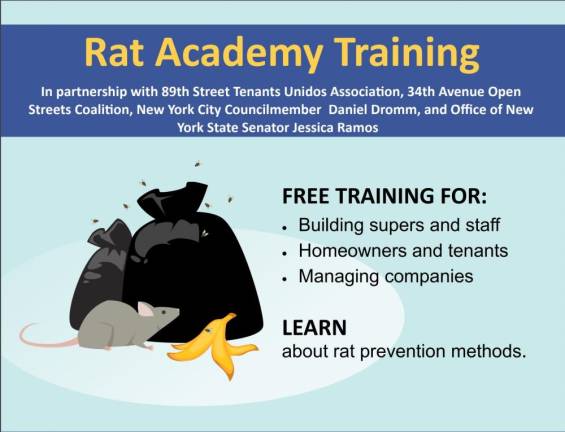Lessons from the Rat Academy
Council Speaker Corey Johnson sponsored a virtual education session on rodent prevention


On Wednesday, Sept. 23, the “Virtual Rat Academy” was in session. The students were not, in fact, rats. Quite the opposite — the seminar was intended for building supers, landlords, homeowners, tenants, and managing companies, who wanted to learn about preventing rats in NYC.
This two-hour session, sponsored by New York City Council Speaker Corey Johnson and led by Martha Morales, Community Coordinator for the Bureau of Veterinary and Pest Control Services at the NYC Health Department, dove deep into the biology and behavior of rats. If any of the participants were hoping for some Rat Fun Facts, this session delivered. Rats can gnaw through anything softer than steel, including concrete, their fur can camouflage over time to match their surroundings, and they can, in fact, climb up toilet systems.
“Believe it or not, some people like to keep rats as pets,” Morales said.
The COVID-19 pandemic has put a new focus on the city’s rat problem, which has existed since the 1700’s, when they were transported to the U.S. from England or France on ships.
Since indoor dining was unavailable this summer, restaurants have heavily relied on outdoor dining. Restaurant doors are left open and food being transported in and out creates a stronger appeal for rats. NY1 reported that in March and April, reported rat complaints were at a record low, but have been increasing since the city began to reopen. Another result of the pandemic was the Department of Sanitation’s budget cut of $1.5 million, which will mean more trash will build up on the city’s curbs.
In addition, the shutdown of businesses led to increasingly aggressive behavior by the city’s rat population. “Community-wide closures have led to a decrease in food available to rodents, especially in dense commercial areas,” the CDC stated. “Environmental health and rodent control programs may see an increase in service requests related to rodents and reports of unusual or aggressive rodent behavior.”
Taking Shelter
As attendees of the Rat Academy learned, New York is home to two million rats. Each female rat can have 4-7 litters in her lifetime, each litter carrying 8-12 rat babies. That’s 84 pups total — in case you didn’t want to do the math.
The problem has sustained itself for so long because New York City has everything rats need to thrive. They can take shelter nearly anywhere that gives them a roof — in cluttered construction sites on the street, in the walls of buildings, and in pipes and subway tunnels underground. Morales informed the class that rats have a special layer of fur on their back that alerts them when they are covered and safe. This is why things like covering the tops of rat burrows don’t help, she explained, because it just reaffirms for them that they are safe and sheltered, and they continue perpetuating their family legacies.
“Rats are New Yorkers, a lot like us,” she said. “Their priorities are food, housing, family, and a short commute.”
The main thing that separates us from the rats is our lack of desire to eat garbage, though we have no problem supplying it. A rat only needs one ounce of food and one ounce of water every day, and New York City residents produce 12,000 tons of garbage each day. There are 32,000 ounces in one ton. More unsettling math.
When garbage is left in plastic bags on the street overnight, Morales said, “we are just delivering food to them.”
Because it’s simply humanly and rattily impossible to keep up with rat reproduction enough to slow them down and stop the problem, Morales provided the attendees with some methods of rat prevention that do work, and some methods that don’t work. Collapsing a rat burrow with a shovel, keeping a clean home or restaurant, and keeping storage at least one foot off the ground, are all things that tell rats that they are not going to find a happy home here.
Leaving out bait poison, traps, and getting a cat, do little to nothing. Poison only kills rats if they have several doses of it; traps are highly unlikely to be more interesting for rats than the mountains of pungent garbage on the curb; and cats simply don’t have the speed (or the ambition, quite frankly) to keep up with the rat population.
Restaurants have always been a hot spot for rat attraction. Though you can be comforted by that “Grade A” in the window of your favorite place to eat, rat prevention has to be active and continuous.
The gist of the session was that going after the rat problem one rat at a time will not achieve much, but instead creating an environment where rats are not enticed to hang around.
“Any rats killed by hunting, baiting, and trapping,” Morales said, “are just the tip of the iceberg.”
The Department of Health will host another virtual session on rat prevention on September 30, and you can register here.
“Rats are New Yorkers, a lot like us. Their priorities are food, housing, family, and a short commute.” Martha Morales, NYC Health Department